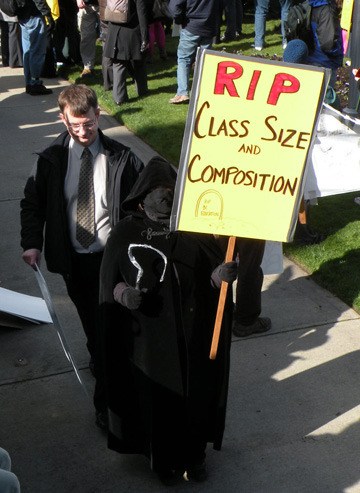VICTORIA – I made an error in a column two weeks ago about the latest court ruling in favour of the B.C. Teachers’ Federation.
I referred to an “illegal” strike in 2012, and was quickly reminded that this teacher walkout was sanctioned by the Labour Relations Board.
After months of withholding report cards and refusing to meet with administrators, the union went to the LRB to seek permission for a full-scale strike.
They got their wish, with authorization under essential services rules for a three-day strike in the first week, and one day a week after that until the end of the school year or a settlement was reached.
For the record, the last illegal BCTF strike was in 2005, in defiance of a B.C. Supreme Court order that resulted in a $500,000 fine against the union.
That was the same year BCTF lawyers won a split B.C. Court of Appeal ruling allowing teachers to bring political propaganda into classrooms. Two out of three judges decided this was appropriate to preserve their freedom of expression.
The authorized three-day strike went ahead in March 2012. Regular readers may recall my reports of students being indoctrinated in classrooms and in some cases sent out as union pickets, and of the strong-arming of unionized government office staff here in Victoria to make them join a rally on the legislature lawn.
This was the strike that, according to the current media and political narrative, the provincial cabinet conspired to bring about. This notion is central to the Jan. 27 ruling of Justice Susan Griffin that orders the B.C. government to attempt to reconstruct the world of 2001.
Government lawyers filed an application with the B.C. Court of Appeal on Friday to suspend parts of this ruling. Imposing Griffin’s terms would cause “irreparable harm to the public interest of unprecedented magnitude,” they said in arguments backed up by a series of affidavits from superintendents who have to keep B.C.’s war-weary public schools running.
In Surrey, returning to 2002 conditions would add $40 million to the district payroll in year one. That’s one of 60 school districts.
The government’s submission includes affidavits from superintendents around the province on its likely impact. Here’s a partial list:
Cancellation of specialty programs for vulnerable youth, construction of portables to meet arbitrary class size restrictions, transfer of some students to other schools, closure of daycare and Strong Start preschool programs to free up space reallocated over the years, layoff of non-teaching staff, and cancellation of school participation in the international student program.
Premier Christy Clark and Education Minister Peter Fassbender have begun to push back against the conspiracy theory that has taken hold, pointing out that when the BCTF finally did get permission to strike, the cabinet of the day acted to prevent it.
Here’s a recap. In late February 2012, nearly 28,000 teachers (90 per cent) voted to go to the full strike allowed by the LRB. The government tabled legislation to impose a cooling-off period with provision for steep fines on the union for any further strike action, and appointed a mediator. This kept schools open, and eventually yielded a two-year deal.
In April 2012, the union voted to withdraw all volunteer work by teachers. By this time they had been ordered by the LRB to prepare second-term report cards, in part so students would know if they could apply for post-secondary studies.
Once again this mess is before the court of appeal. Perhaps there will be better recognition of the real world this time around.
Tom Fletcher is legislature reporter and columnist for Black Press. Twitter: @tomfletcherbc
